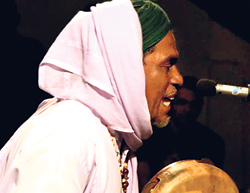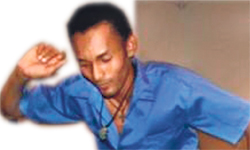It’s not often that live African music can be heard on the streets of Colombo, but last week the sounds spilled into the alleyway adjacent to the Barefoot Café and onto Galle Road, filling the night air with pulsating thumps and infectious singing while over 300 electrified audience members clapped along with the beat.
The Kaffirs, a 12-piece band from the northern village of Sirambiyadiya near Puttalam, were in town and for one night concertgoers were treated to songs whose roots extend back hundreds of years to the African continent, and have been passed down in their original form from generation to generation.
Until very recently, The Kaffirs kept their musical traditions alive in obscurity while their community, descendents of African slaves brought here by the Portuguese, Dutch, and British, became increasingly assimilated with Sinhalese and Tamil culture. That obscurity could disappear with more concerts like the one given last week. With their frenzied and gorgeous performance, The Kaffirs literally brought the audience to their feet in an outpouring of enthusiasm. And with an upcoming appearance on Livechart on November 19, the group appears slated to become a part of the national consciousness like never before.
 |
“They have a very valuable music,” said S.R.M. Mohamed Irshad, who works as a community organizer in Puttalam. “We want to come out and share their activities so that The Kaffirs in Sri Lanka are the number one music group.”
A greater interest in their music could bring a greater interest in the Kaffir community’s unique history, which has till now received scant attention from scholars in Sri Lanka or abroad. As a result, the Kaffir’s past remains largely undocumented and their oral history unrecorded.
Even the majority of Sri Lankans know little or nothing about the Kaffir community--a living embodiment of so much of the country’s colonial past--and the fate of the thousands of slaves that were brought to the island long ago.
“There are almost no books that talk about Kaffirs more than a slight mention in one or two sentences in some histories about Sri Lanka,” said Anuththaradevi Widyalankara, a senior lecturer at the University of Colombo who is preparing a monograph for release next year about Kaffir history.
“Since they are still an ‘unpopular’ and, to a certain extent, an ‘unimportant’ community because they are not indigenous to Sri Lanka, no efforts have been taken to preserve them by the central authority.”
Other scholars such as Shihan de Silva Jayasuriya of the University of London have called the Kaffirs the “forgotten minority”. At a UNESCO conference held in 2004 about the slave trade and slavery, Jayasuriya said, “Since the Sri Lankan government is not responsible for their migration from Africa, an ethical vacuum has been created.”
Jayasuriya remains one of the only international scholars who has published a large body of work on Kaffir history, detailing how the original slaves, taken from places like Mozambique via Goa, were brought to the island to fight as soldiers for the Portuguese.
When the Dutch defeated the Portuguese in 1658, many of the African soldiers switched alliances and some began fighting for the king of Kandy, a Dutch ally, while others worked as labourers in the building of Dutch fortresses.
According to one Dutch governor, around 4,000 Kaffirs helped to build the Dutch fortress in Colombo in the late 1600s. At night, they were kept segregated from the general population in the area appropriately called Slave Island.
In 1796, British rule over Sri Lanka began and the new power continued the colonial tradition of using the Kaffirs as soldiers. In the 1800s, the British Third and Fourth Ceylon Regiments included 874 Africans. When the Third Ceylon Regiment’s detachment in Puttalam was disbanded, the soldiers were given land to settle there.
Though some Kaffirs arguably held a relatively elevated role during Sri Lanka’s colonial period because their military skills were in demand, their story is also one of extreme suffering, according to Widyalankara of the University of Colombo. “The colonial rulers who brought the Kaffirs into this land treated them harshly,” said Widyalankara. “In some travel documents from the 17th century it is reported how the Kaffirs often attempted to run away and hide themselves amidst the Sinhalese. I call the story of Ceylon Kaffirs a tragedy because they were severely suppressed by their colonial rulers.”
In his book Ceylon and the Portugese, the historian P.E. Pieris wrote, “In Goa, the torture and murder of slaves grew to be so gross a scandal as to call for a special Alvara from the King. The Portuguese also retained a large number of female slaves, from whose industry and from commerce of whose bodies their masters derived a considerable revenue.”
Today, there are roughly 200 families of Kaffir origin in the Puttalam district with a further ten to 15 families in Batticaloa and Trincomalee area, according to S.R.M. Mohamed Irshad. They work as domestic servants and labourers for as little as 200 rupees per day.
Only a few members of the community continue to speak the Sri Lankan Portuguese Creole of their ancestors and there are few if any African influences in their clothing, food, or language. After years of assimilation through marriage, only three things belie their past: their Roman Catholicism, curly hair, and African music. “Our grandmothers and grandfathers were always playing this music,” explained George Sherin Alex, a member of The Kaffirs.
“And we listened very carefully because we love this music.”“We are addicted to this music,” added Kovilaga Lowstey Christy, also a member of the band. “We are dancing exactly like our grandmothers and grandfathers did.”
The Kaffirs in Puttalam call their music manja, a creole version of the Portuguese word manha, which comes from marchinhas or “little marches.”
In the past, the music has been mislabelled as kaffrinha but this term more accurately describes the music and dance popular among the 18th and 19th century Burghers that has since influenced popular Sri Lankan music, according to ethnomusicologist Vasana K. de Mel.
Manja songs contain few lyrics, just six or seven lines and sometimes less, which are repeated over and again. But each song can last as long as an hour, starting with a slow beat and increasing in tempo until the music reaches a crescendo of drumming, shouting, and clapping.
Sherin Alex said that many of the songs are about nature, such as one that describes a child flying a kite in the sky. “We sing songs about love, the sea, animals, birds and devotional songs,” she added.
The Kaffirs use instruments like the double-headed dholak drum and the tambourine-like rabana, both of which are played by men and women, but they also employ everyday household items such spoons, bottles, and coconut shells.
At last Sunday’s concert, the group’s first song began with the sound of fingers lightly tapping the surface of the dholaks, while half a coconut shell tapped on the ground kept a steady beat and two spoons clinking against one another provided adornment.
The group began to harmonize and one of the women stood to dance, matching the slow rhythm with her bare feet. From her outstretched hand, she dropped pink flower petals onto the rug beneath her.
Steadily, the intensity of the drums grew and the beat quickened. A male member of the group stood up to dance and with increasing passion and abandon, the two began twirling, swiveling their hips, and stamping their feet on the ground.
“When the fast parts come they are automatically up and dancing,” explained Irshad, laughing. “We can’t control them.”
During a break from the music, the organizer of the concert, Jesse Hardman, addressed the crowd, explaining how he had met The Kaffirs six months ago while travelling for the international NGO Internews.
One of the reasons for bringing the band to Colombo, he said, was to expose more Sri Lankans to the extraordinary ethnic diversity of the Kaffir community.
Hardman was followed by a performance by Nayna Mohammed Bawa, a traditional Faqir singer with Indian and Arabic origins, who sang devotional songs to Allah in a beautiful and penetrating voice.
When the show eventually ended and The Kaffirs had taken their bow, audience members refused to let them leave the stage and shouted for more. The band, exhausted, shook their heads. Finally, Irshad stepped in and cajoled them to play just one more song.“Ok, they’ll play,” Irshad shouted to the audience. “But are you ready to dance?”
|


